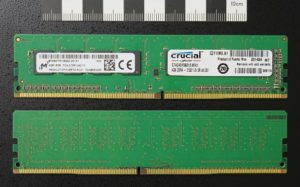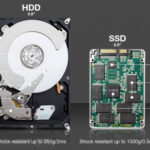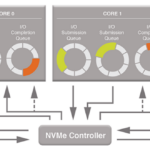DDR SDRAM is a stack of acronyms. Double Data Rate (DDR) Synchronous Dynamic Random Access Memory (SDRAM) is a common type of memory used as RAM for most every modern processor. First on the scene of this stack of acronyms was Dynamic Random-Access Memory (DRAM), introduced in the 1970s. DRAM is not regulated by a clock. DRAM is asynchronous, i.e., not synchronized by any external influence. This posed a problem in organizing data as it comes in so it can be queued for the process it’s associated with. Because DRAM was asynchronous, it was not going to work as fast with processors that were just getting faster.

Many people refer to a processor’s RAM as simply “DDR”, using the terms interchangeably because DDR is so widely used as CPU RAM and has been since the late 1990s. DDR is not flash memory like the kind that is used for Solid State Drives (SSDs), Secure Digital (SD) cards, or Universal Serial Bus (USB) drives. DDR memory is volatile, which means that it loses everything once power is removed.

This may seem like a detriment, but the trade-off is that DDR has much faster transfer rates than other memory products, as well as a high capacity. The ubiquitous use of DDR SDRAM for a processor’s working memory, or RAM, has improved over the years as the industry has progressed from DDR to DDR2, DDR3, and now DDR4 SDRAM (see Table 1). DDR2 – DDR4 evolved to require lower supply voltages, which generally saves power. Other changes were made to increase the speed, as well. DDR2 SDRAM was reduced to operating at a voltage of 1.8 volts, and a clock multiplier was added to the memory module to again double data transfer speeds while operating at the same bus speed. DDR3 RAM integrated a 4x clock multiplier, again doubling the memory transfer rate for the same bus speed.
TABLE 1: Comparison of SDRAM in order of release. Clock and transfer rates are approximate and vary by manufacturer.
| Standard (Approximate Year Introduced) | Operating Voltage | Amount of Data Transferred (Words per Clock Cycle) | Associated RAM Clock Rates | Approximate Transfer Rates |
| SDRAM (1993) | 3.3 V | 1 | 66 – 133 MHz | 100 – 166 MT/s |
| DDR SDRAM (2000) | 2.6 V, 2.5 V | 2 | 100 – 200 MHz | 200 – 400 MT/s |
| DDR2 SDRAM (2003) | 1.8 V, 1.55 V | 4 | 200 – 400 MHz | 400 – 1066 MT/s |
| DDR3 SDRAM (2007) | 1.5 V, 1.35 V | 8 | 400 MHz – 1066 MHz | 800 – 2133 MT/s |
| DDR4 SDRAM (2014) | 1.2 V | 8 | 1066 – 1600 MHz | 1600 – 3200 MT/s |
In addition to a steady decrease in operating voltage and power consumption, DDR also became denser as more transistors were packed into a smaller area. DDR SDRAM is packaged as an integrated chip module, which includes the Dual In-Line Memory Module (DIMM) used with desktop computers. DIMM is a small PCB populated with SDRAM chips. Before DIMM, we had Single In-Line Memory Modules (SIMMs), which were used in the 1980s and 1990s. DIMM chips carry DDR SDRAM for upgrading RAM on a PC.
This article discusses the more modern versions of volatile RAM, including general points on DDR SDRAM standard and how it evolved. Before DRAM, there was the also-volatile SRAM (Static Random Access Memory). The fundamental differences between DRAM and SRAM were covered in an earlier post. More on non-volatile memory can be found in an earlier post Embedded use of NAND and NOR flash memory is evolving.
DDR5 SDRAM is the next standard proposed to double the speed of DDR4 SDRAM. According to the JEDEC Solid State Technology Association, the standard-bearer for DDR SDRAM, “The JEDEC DDR5 standard is currently in development in JEDEC’s JC-42 Committee for Solid State Memories. JEDEC DDR5 will offer improved performance with greater power efficiency as compared to previous generation DRAM technologies. As planned, DDR5 will provide double the bandwidth and density over DDR4, along with delivering improved channel efficiency.” DDR5 SDRAM is forecasted for 2018.





there’s not system
Nice article!